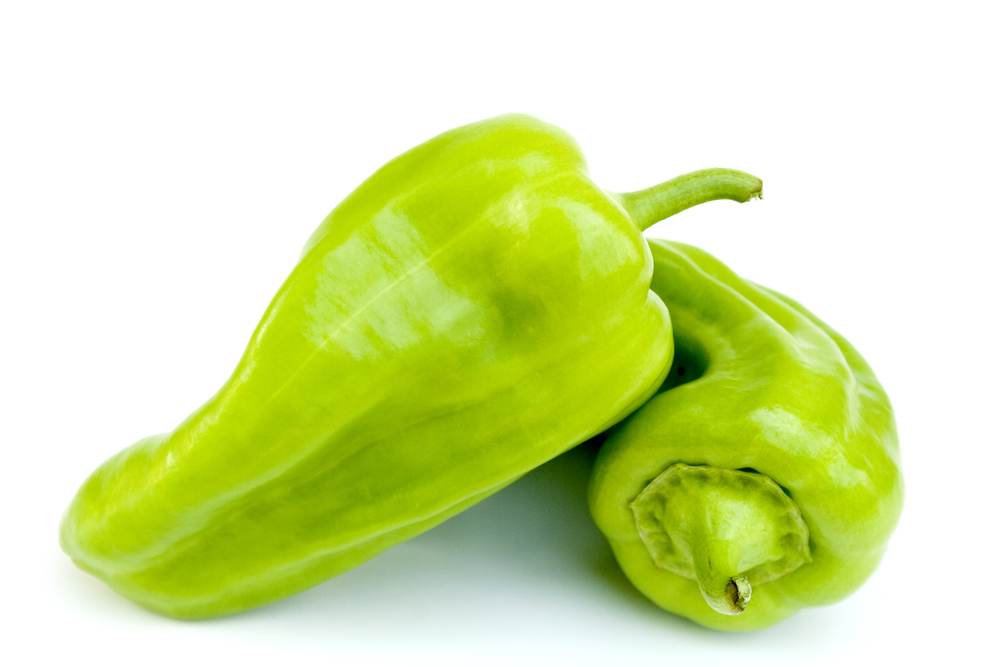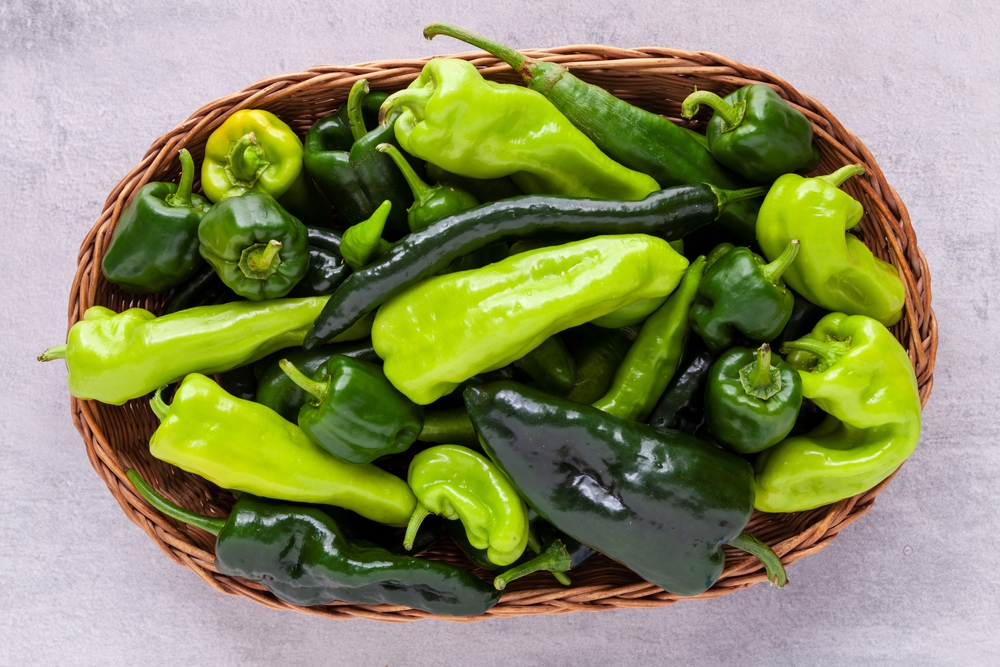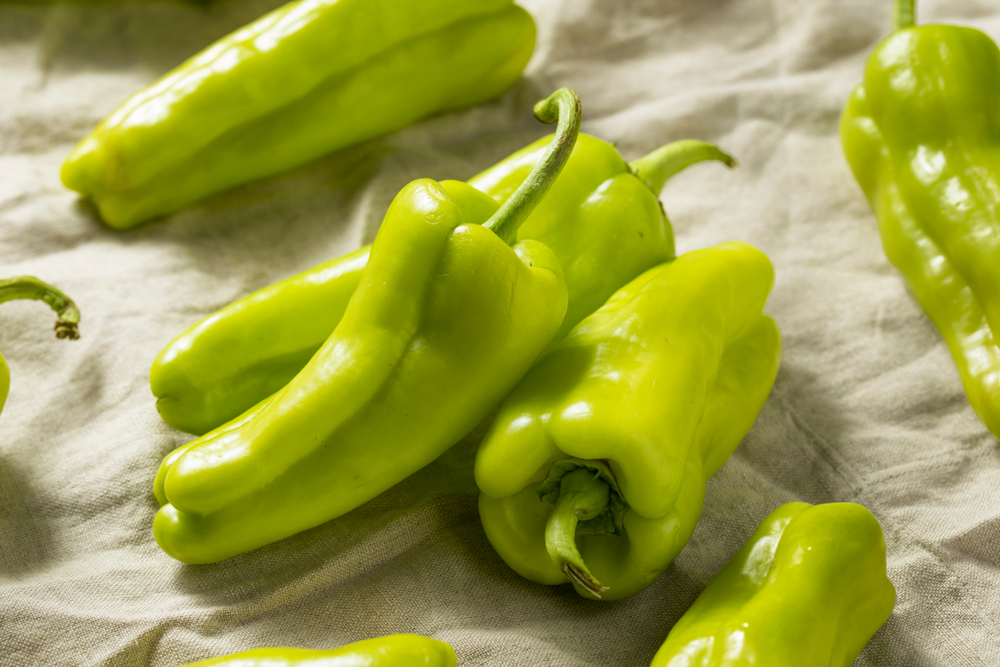Cubanelle peppers are a variety of sweet pepper belonging to the capsicum annuum species. Also known as the Italian frying pepper, it has Italian roots dating back to the 1800s. While the Dominican Republic is the leading producer, cubanelle pepper forms a classic part of the south, central, and Latin American traditions. Almost no Cuban or Puerto Rican authentic cuisine is complete without cubanelles.
What Are Cubanelle Peppers?
The cubanelle pepper is a sweet pepper that is 6-8 inches long and 2 inches in diameter, with a curve at the tip. It’s tender in texture due to low water content, is smooth, and may have little wrinkles on the outside.
In appearance, the color and shape can make it hard to differentiate from a banana pepper or Hungarian wax pepper. When unripe, it has a yellowish-green color turning bright red on ripening.

Cubanelle pepper gives your dishes a sweet (honey-like), mild, flavorful taste and is crunchier than bell peppers. The mild heat makes it a favorite in Cuban and Italian cuisines, as you don’t have to worry about extreme spiciness.
Are Cubanelle Peppers Hot?
Cubanelle pepper is mild in heat with a range of 100-1,000 SHU on the Scoville scale. It’s considered a sweet pepper, like banana peppers, pimento peppers, and bell peppers.
Poblano (1,000-1500 SHU) is slightly similar in size but has a higher heat level. Compared to Anaheim (500-1,000 SHU), cubanelle peppers are sweeter and less spicy. The hottest jalapeno is five times hotter than cubanelle, while the mighty habanero (350,000 SHU) contains 350 times more heat than this thin-skinned pepper!
What Are Cubanelle Peppers Used For?
There are many creative ways to use Italian frying peppers. Its sweet heat and quick cooking time make it a favorite ingredient for various authentic Cuban and Italian foods.
Traditional recipes involve stuffing the peppers (carefully!) with meat and cheese mixtures, then baking. The thin, soft skin with low water content is an excellent fried pepper topping for sausages and sandwiches. You can also enjoy them raw or pickled on subs and pizza. To add lots of flavor and medium heat to a bland omelet, salad, soup, or pizza, cut your cubanelle pepper into thin slices and enjoy it raw, pickled, or sauteed. They’re even delicious in a fruit salad!
They can also be added to your soups and salsas or blended into a yellow mole. In your favorite recipes that call for classic mirepoix or sofrito ingredient, swap the bell pepper for a cubanelle.
Check out this recipe for fiesta breakfast casserole, but consider swapping the green bell pepper for cubanelles. These sweet, mild peppers are also delicious in vegetarian Moroccan couscous with chickpeas, and peppered Chinese beef with black beans.
Are Cubanelle Peppers Similar To Poblano Peppers?
Cubanelle and poblano peppers share some similarities, but they have some distinct differences. But both peppers are good for stuffing despite their different skin thickness and heat levels.
Cubanelle Chile (100-1000 SHU) is less spicy, has a sweet, crispy taste, and is banana-shaped. Poblano peppers (1,000-2,000 SHUs) has thick skin, is heart-shaped, and has an earthy, smoky taste with more heat. Poblano is also smaller in size, around 4 inches long and 2 inches wide.

Are Cubanelle Peppers And Banana Peppers The Same?
No, cubanelle peppers aren’t the same but have very similar features. Judging by their appearance, it can be tricky to tell the difference, except when it comes to size – banana peppers are much smaller.
Cubanelle and banana peppers are both yellowish and have similar shapes and textures. The two chilies are best for sauces, salads, pizza, and sandwiches. However, Cubanelle pepper is sweeter and hotter than the banana pepper, which only has a 500 SHU. The difference is minor, so you can easily swap them out in recipes that call for sliced or diced peppers.
Where To Buy Cubanelle Peppers
Like bell peppers, cubanelles are widely available in supermarkets worldwide. Their growing popularity makes them easy to find in stores selling fresh specialty fruits and vegetables.
You can also get cubanelle peppers during summer in most farmer’s markets worldwide, including the U.S, Puerto Rico, and Dominica republic. Online vendors such as Amazon often stock cubanelle pepper pods and seeds.
Can You Grow Cubanelle Pepper?
Yes. Like other peppers in the capsicum annum species, cubanelles and bell peppers have a simple growing process. They take between 62-65 days from planting seeds to maturation. Since they don’t need pruning, they are low-maintenance and do well in all climates.
In any climate, cubanelle peppers need regular watering, proper spacing, full sunlight, and rich soil to give you a bountiful harvest. It takes 10-14 days for your pepper seedlings to germinate under warm, moist temperatures. According to experts, pepper plants will not set fruit at temperatures below 55F, so it’s important to wait until the risk of frost has passed before planting or transplanting outdoors.
Amazingly, cubanelle peppers produce better with regular harvesting, so as soon as one is ready, snag it!
Substitutes For Cubanelle Peppers
Can’t find any cubanelle peppers left on the supermarket shelves? Fortunately, there are a few excellent substitutes you can try:
Banana peppers
These chilies have a shape, size, and sweetness similar to that of cubanelle peppers. Pickled Banana peppers are also great with sandwiches and salads. Despite its thicker skin, you can use it instead of cubanelle pepper for stuffing. Banana peppers (500 SHU) make an excellent cubanelle pepper substitute if you want a relatively sweet pepper.
Poblano peppers
With a rating of 1,000-1500 SHU, poblano peppers give you a slight heat level upgrade in the absence of cubanelles (100-1,000 SHUs). Poblano is best when stuffed or sautéed like Italian frying pepper. While they possess similar features, the earthy, smoky poblano will not give you the same light, crisp flavor of a cubanelle pepper.
Anaheim Peppers
Anaheim peppers make an excellent cubanelle substitute based on size, shape, and color. They also give your dishes mild-moderate heat, but with a slightly smokier, sweet flavor.
Bell peppers
Aside from belonging to the same species, bell peppers give your dishes the same sweet taste as cubanelles. While they have a much thicker skin, if you use a yellow bell pepper and slice it thinly, it’s an easy swap for recipes.

